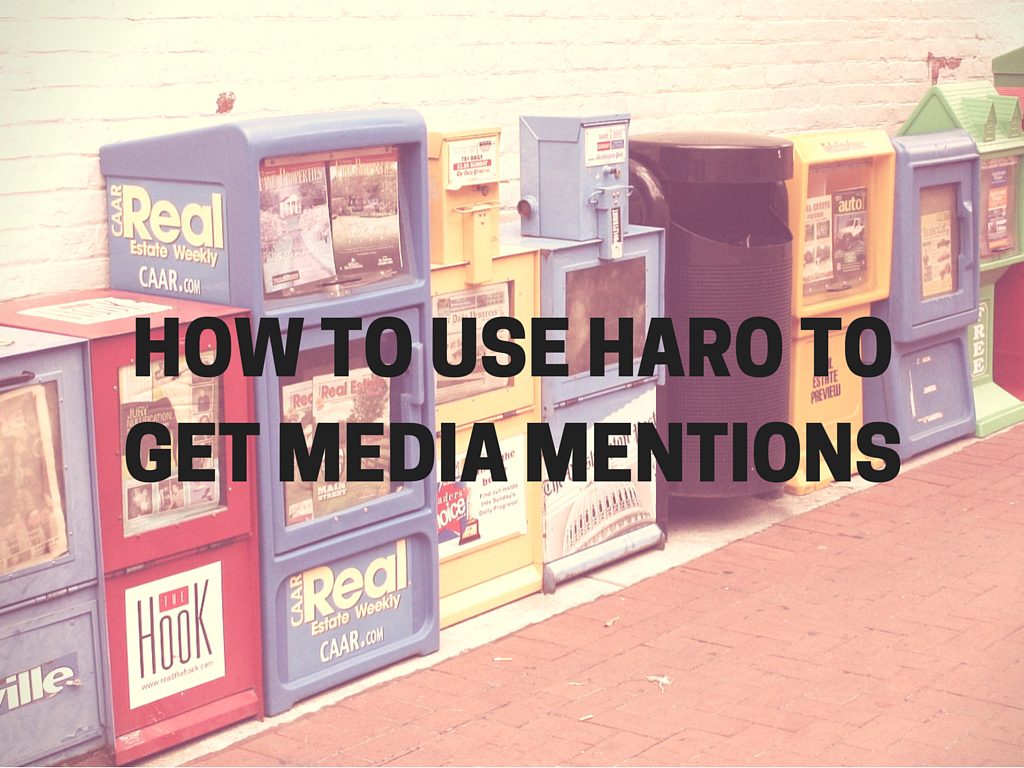 There’s a tool I love for getting mentions on bigger sites and news outlets. It’s called HARO. It stands for Help a Reporter Out.
There’s a tool I love for getting mentions on bigger sites and news outlets. It’s called HARO. It stands for Help a Reporter Out.
Created by Peter Shankman, it helps connect reporters with people who can help them with stories.
Sort of like outsourcing information. But, in a good way.
For the longest time, I had subscribed to the site and never used it.
Yea, that was dumb.
Now, I’m all up on HARO. And guess what, it’s worked for me.
What’s the point, you ask?
There are a few actually:
- Spread the word about you, your site, or your business
- Establish yourself as an “expert” in your field
- Make connections with journalists and other bloggers
- Boost your SEO
Convinced?
Let me show you how I use HARO.
Step 1: Sign up for HARO
Here’s how you do it. Hop over to helpareporter.com.
If you want to use help a reporter to offer your tips and information to reporters, click the blue “I’m a Source” button.

If you are a journalist who wants to use sources for your story (i.e. you want a roundup post from marketing experts on using social media for holiday sales) then sign up with the “I’m a Journalist” button.
They have a couple of pricing options. The free service covers the bare basics, you get an email three times a day. That’s all I’ve been using.
The more you pay for the other services, the easier it makes it for you to be able to reply.
In the Standard Tier, for example, you can choose a keyword to filter your choices. That’s cool if you have a specific niche you operate in, say social media. Then you can filter all the requests to just ones concerning social media.
For your purposes, just starting out, the free service will work just fine.
Click the blue “Sign up” button.
Next, just fill out your information, and click “Submit.”
You’ll get an email in your inbox asking you to click a link to activate your account.
Here’s it is:
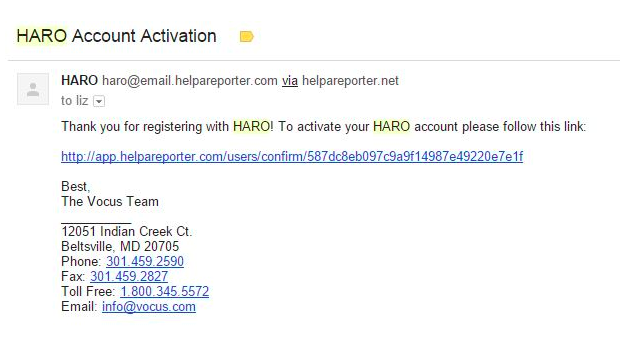
Click on the link and you can log into your HARO account and get started.
Step 2. Set Your Profile
Once you get back inside HARO fill in your account details. Don’t forget about this otherwise, you could find your inbox inundated with emails that don’t apply to you. That’s a quick way to ignore HARO from the jump.
Ahem…I know from experience.
So, hop on the site and fill out your profile. The biggest thing you want to pay attention to is the HARO Preferences box.
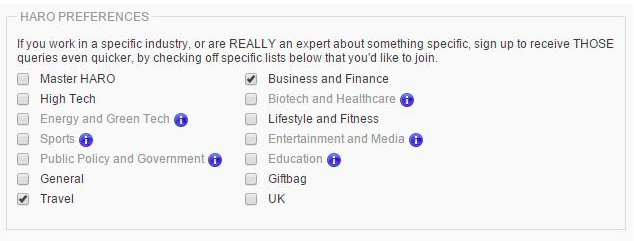
Don’t check all the boxes. It’s way too much to sift through. Plus, you should have an understanding of your target industry.
Look at a couple of the choices and see what will work for you.
If you have a travel blog, clearly travel is a good choice. If you’re a fitness copywriter, lifestyle and fitness is where you want to live.
Business and Finance, which is one I subscribe to features a lot of topics in real estate, social media, and general entrepreneurship, among others. If you’re in any of those industries that’s a good choice.
Worst case, click what you think might work, checking the emails over the course of a week or two. You can always tweak.
HARO adds new categories from time to time, so check back in every few months to see if there’s a new category in your field.
You can also change from being a source to a reporter up at the top (or if you want to do both). Everything is flexible.
Once you’re good, click “save and update.”
Join over 40,000 people who have taken our 6 part freelance writing course. Sign up below and let’s do this together.
By entering your email address you agree to receive emails from Location Rebel. We'll respect your privacy and you can unsubscribe at any time.
Step 3. Monitor Your Inbox
HARO will send you emails three times a day, Monday through Friday.
The times are early morning around, early afternoon and early evening Eastern Time.
Here’s what the email looks like:

The emails are hyperlinked so you can scan them easily and click on the queries of interest to you.
Here’s a little pro-tip: try to check the emails right after they arrive in your inbox.
Some will give you a few days to answer, others run under a tight deadline. A 12:35pm email might have a 5pm deadline. If you miss that, you’re out of luck.
Step 4: Understand the Queries
I bet you thought step 4 would be pitching.
Nope, not so fast. The queries are designed to give clues that will help you have a good pitch outcome. Pay attention.
Here’s what every query will have:
Name: This is the name of the reporter, occasionally they will be anonymous
Category: This is the name of the category (i.e. if you get an email from HARO in Business and Finance, that’s the category)
Email: The email address of the reporter (this is anonymous so you can’t bombard them with a million emails)
Media Outlet: This is the place the journalist is writing for so sometimes you’ll see something general like Newspaper. Other times it will say the name of the publication
Deadline: This is the date and time (pay attention to these) you have to submit your pitch by
Query: This is the actual background on what the reporter needs. Read this carefully.
Requirements: The instructions the journalist wants you to follow (Hint: if you actually follow these you’ll have a much better level of success)
Let’s take a look at an example:
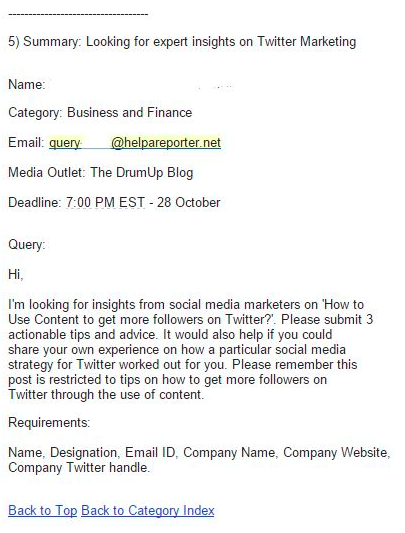
Pretty self explanatory. In this case, I’ve removed the name of the reporter and the identifier in the email for privacy.
Got it?
Let’s get to the pitch.
Step 5: Preparing for the Pitch
Now we get to the pitching part. This is where you make it or break it.
Just a caveat first. If you pitch and don’t get a response don’t get discouraged.
Tons of people are emailing these journalists at once, sometimes it’s a matter of not being the right fit, other times it’s just your pitch stinks.
Sorry, boo, but it’s true.
Alright, remember how I covered the details of what the query looks at? Details are the important part here.
Let’s use the example from above and break it down a bit more.

Now, look for details before you pitch to see what is most important.
What to Look For
A couple of things jump out with this one.
First, the question: “How to Use Content to get more followers on Twitter?” This is what they want to be answered.
Here’s what they don’t want:
- What you think is an amazing answer to a totally different question.
- Your thoughts and feelings on social media.
- Or your suggestion to check out your site.
She wants “3 actionable tips and advice.” When they ask for a specific number in their query, give them that number.
It’s also a hint the journalist is in need of help.
When reporters ask for multiple tips it typically means they get the same 4-5 tips over and over. That makes her job harder, and her article boring.
Help her out by giving at least one tip that is really creative, interesting, or out of the box. This is where you can shine.
Next, follow directions.
She specifically dedicates a line in her query to ask you to please follow directions: “Please remember this post is restricted to tips on how to get more followers on Twitter through the use of content.”
She doesn’t have time to sort through all the people who don’t follow directions. Get known as someone who follows directions. It’s a good place to be.
Finally, check out the other hints that will help you.
When you see things like “tight deadline” in the query, you want to submit your pitch as soon as you can. You’ll have a much better chance of being included.
So let’s look at how you can answer this.
Step 6: Pitch Reporters
Now we get to the pitch.
Here’s how you can pitch the reporter.
HARO gives you two options to send your pitch. Inside HARO, or via email. I tend to pitch via email.
If you want you can pitch inside Help a Reporter Out. Log in and go to your dashboard. Next to “My Account” you’ll find “My Pitches.”
You’ll see “Things You’ve Pitched.” I’m not 100% sure if all the pitches sent via email are entered into the system, so just be aware of that.
Here’s what mine looks like:
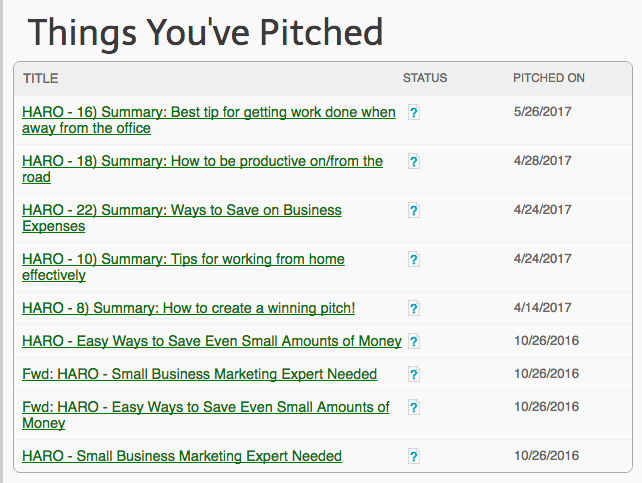
On the right, you’ll see a small link that says “Submit a Pitch.” Click that.
A new page opens.
You’ll see a space to fill in the reporter email (you’ll have to copy and paste this from the query), a space for the subject, and a space for the pitch.
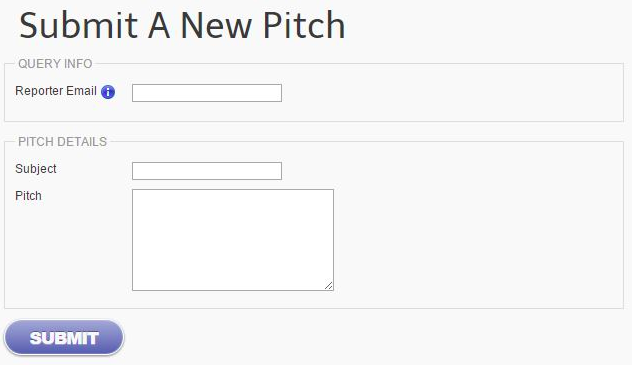
Fill all that in and click submit.
I usually respond via my own inbox. Just open up a new email, copy the anonymous address and start your pitch.
Here is an actual example I just did recently that worked:
The Query
This was the query from the reporter (I’m guessing you recognize it by now):

The Pitch
Here was my response (I copied and pasted for ease of reading):
Hey [Reporter],
Responding to your request for tips on Twitter Marketing.
Here are my 3 tips on how to use content to get more followers on Twitter:
1. Create visuals to go along with your tweets. Research has found that having a photo in your tweet can increase engagement by over 30%. That means your content will get more favorites and retweets just by using a tool like Canva to create a title image or a quote image from your content and attaching it to your tweets.
2. Mention the people, websites, tools, etc you cite in your content. If you write a post that is your 10 favorite productivity tools, for example, be sure when you tweet out your content you mention those tools on Twitter. They will be far more likely to share that content with their followers, thus dramatically increasing the number of people your content is exposed to and increasing followers.
3. Engage and interact with your current followers. When you are creating new content, do so with your followers in mind. Focus on creating content that your followers will love and want to favorite and share. One of the best ways to get new followers is to have your current followers spread the word. It’s been seen that social influence is a huge factor online.
My name is: Liz Froment
Email: [email protected]
Company website: lizfroment.com
Twitter: @lfroment
Thanks.
You can see I followed directions.
Gave her three answers, each a few sentences long, plus all my contact information in a way that was very easy for her to copy and paste. I linked my blog and Twitter account too.
Remember, if you think about how you can pitch yourself in a way that is going to make life easier for the reporter, you’re going to see a lot more success.
A few final tips:
- Keep your answers simple and to the point.
- Answer the question they ask.
- Don’t go off on tangents.
- Don’t take up more of their time than needed.
- Leave all your contact information.
Want more on how to send way better pitches? Check out the cold email checklist.
Step 7: Wait (and Search)
Once you click send (or submit) that’s it.
Don’t be a pain in the ass and follow up with the reporter to see what’s going on.
If they like your quote they’ll use it. If they don’t, move on to the next.
In an ideal world, you can start using Help a Reporter Out two main ways.
First, is building relationships with reporters and the people who are looking for information:
Give them the blurbs they want consistently and they might just start coming back to you for the next story before they even hit HARO.
Second, this is a great way to help work on building your brand. When you get your mentions of features, you can use the logos of the sites on your freelancer website or business website and include these links in your portfolio or press page too.
So think about the big picture and know it could take a few weeks for the post to be published.
Step 8: Save Your Content
What I have found is most of the time the reporter will come back to you if you’re in the article and provide a link to the story. Be sure to thank them and tell them you’ll share on social media.
Sometimes they won’t.
I Googled something the other day and accidentally found myself quoted in a HARO query I had submitted months ago and never knew I was in. So you might want to keep a Google Alert on yourself (welcome to the big time!).
I also use Streak CRM with my Gmail to help me keep track of these pitches too since I send them off via email.
In the case of this pitch above, the reporter did come back and provide me with the link to the post.
Here it is 11 Solid Tips for Effective Twitter Marketing from the Pros.
One of the three I submitted got featured with a bunch of marketing directors and other social media experts. This helps establish me as someone who knows a little something about content marketing and gets my name out there.
All in all, it wasn’t much work for a bit of nice exposure.
That’s just one example, I’ve used HARO a bunch of times successfully, not only for myself but also clients.
Try Help a Reporter Out for Yourself
Think you’re ready to give it a shot? Or have you already had success and have some of your own tips to offer?
Would love to hear your thoughts. Let me know in the comments below.
Liz Froment
Liz Froment is a full-time freelance writer and the one who keeps Location Rebel running like a well-oiled machine. If she's not writing something informative or witty for her clients, she can most likely be found reading a good book.Join over 40,000 people who have taken our 6 part freelance writing course. Sign up below and let’s do this together.
By entering your email address you agree to receive emails from Location Rebel. We'll respect your privacy and you can unsubscribe at any time.

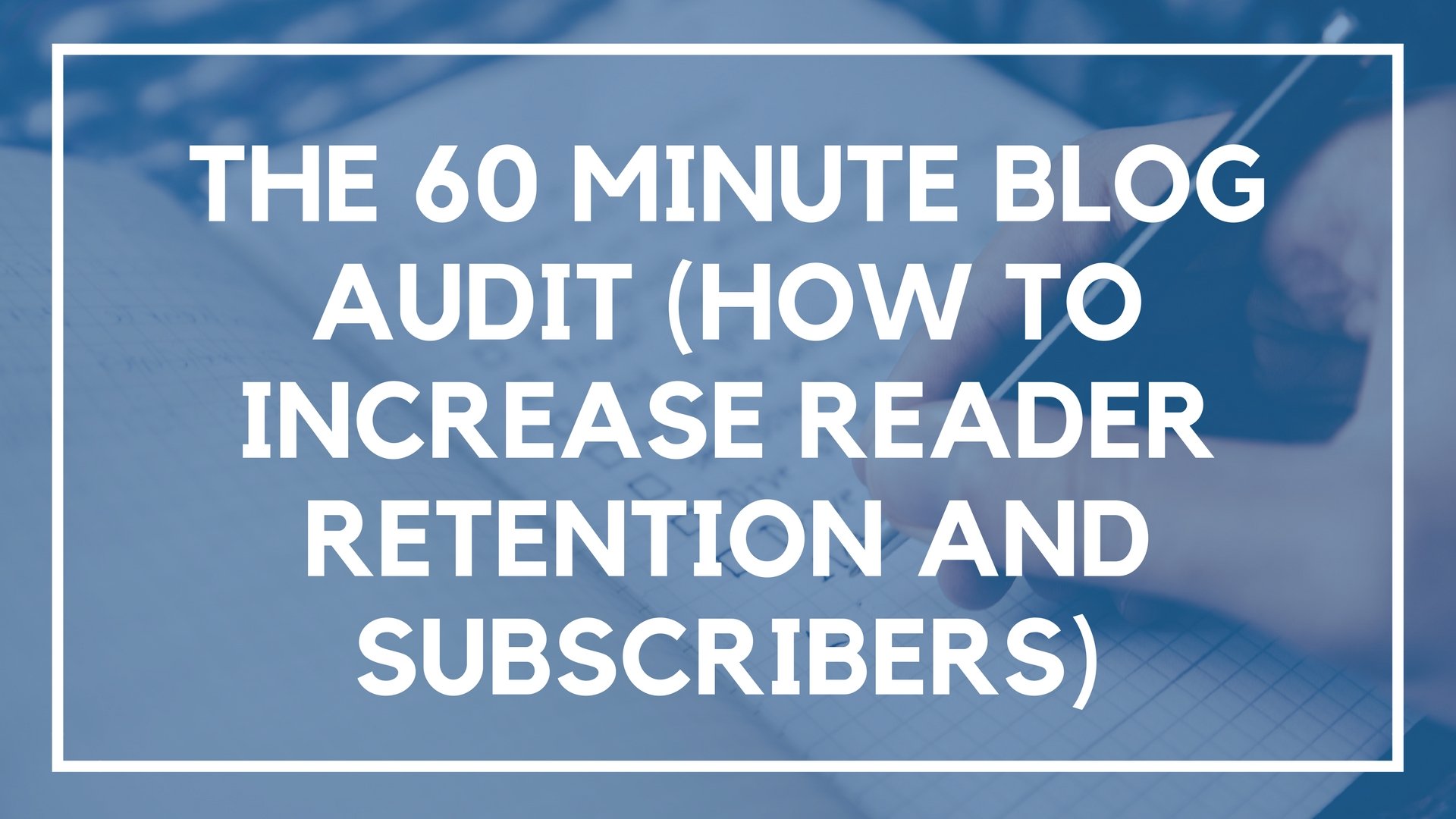
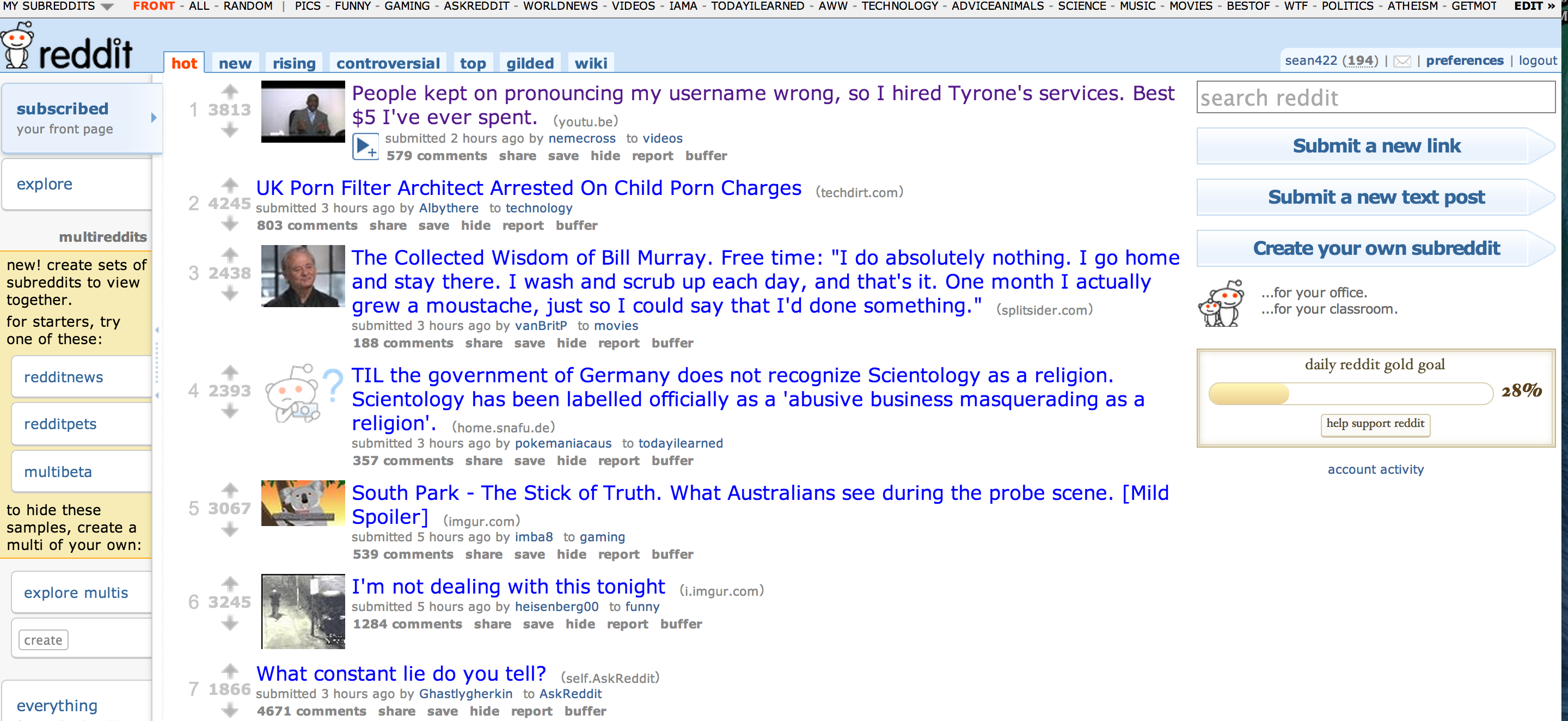
This is a great guest article. In going to check out HARO now.
Thanks, let us know how it goes!
Interesting post. I’a gonna have a closer look on haro.
For sure, check it out it’s pretty easy to get started.
This is incredible. If you’re actually an expert in your field, you could end up getting so many mentions with this! I guess you just have to hope they don’t take your quote and run off with it though, but I suppose that’s just part of the game so to speak.
True, I suppose that is a concern, but I’ve had very good experiences with HARO myself.
This was a great post. I joined HARO a while back at the recommendation of another blogger, but now I feel like I understand how to use it to my advantage. Thank you.
Awesome, thanks Aaron!
I’ve never really considered Haro, is it better than twitter or pinterest?
I use it to compliment, rather than instead of. Just another tool to add to the arsenal!
Love HARO! I find it’s a great way to “stretch” myself, answering questions I wouldn’t have thought I could.
Awesome, I do too! 🙂
Thanks for the tips! I always wondered how to answer those queries on HARO. I’ve had an account since last year but was never able to use it.
Hopefully now you have some ideas. Just start replying, even if it’s just a few sentences to get the hang of it.
Good tips on using HARO. I have to add that persistence is key.
Yup, for sure I agree with that Cindy. I just make it a habit of replying to as many as I can for myself or people I’m working with.
Thanks for an excellent guide. One question for you–I know HARO says not to include attachments in your responses, to protect reporters from viruses. But what about embedding a photo within the email itself? I pitch products, not a service, so no matter how well I might describe a product I’m pitching, a photo is worth a 1000 words, as the saying goes.
Any suggestions on this?
Hi Stephanie, if you want to add a photo you can certainly copy it into the email. Or, you could upload the photos to a Google Drive or Dropbox folder and then share the link for the reporter to have access. The key is to mention what’s inside the link, but yes, there are certainly times where having a photo can really push things over the top. Good luck!
It has been a hell no luck for me getting a mention for over 3 months now using HARO, but then, i’m going to implement your tips here.
Thanks for the guide Liz